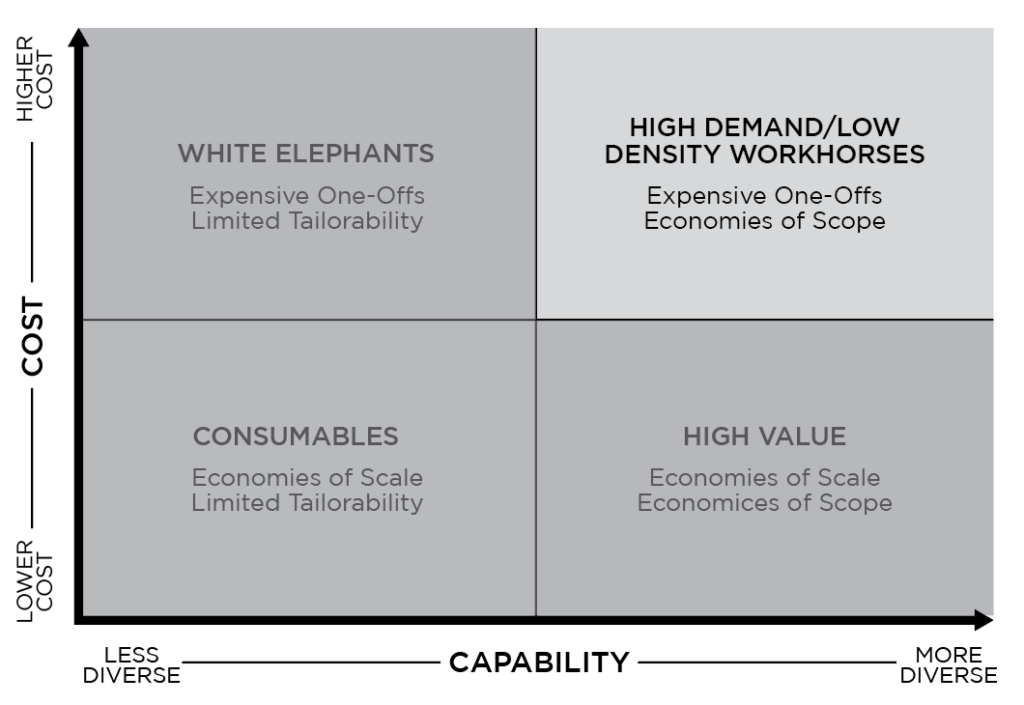Progress relies on bold organizations pushing boundaries with pioneering inventions redefining entire paradigms. But charting new frontiers carries immense risks, demanding exceptional discernment balancing long-term strategic necessity against short-term fiscal realities. Let’s take a deeper look at this problem through our cost and capability matrix, looking at our final quadrant.
Did you miss the rest of the series?
Part 1 Intro to the Cost Capability Matrix
Part 2 | Assessing the Cost-Capability Tradeoff, Quadrant 1 – Consumables
Part 3 | Navigating the Cutting Edge: Investing in Specialized Innovation, Quadrant 2 – White Elephants
Part 4 | Calibrating Capabilities and Costs for Widespread Adoption, Quadrant 3 – High Value

Insights into High-Demand/Low-Density Workhorses
Quadrant 4 contains complex customized solutions with enormous price tags and broad flexibility catering to a niche, specific application with a wide range of diverse capabilities. These genesis innovations pioneer entirely new concepts while custom-built offerings address unique constraints through specialized tailoring. Think Lockheed Martin F-35 Lightning II, VR headsets in their infancy before standardized designs, self-driving vehicles under current R&D lacking widespread production, or conceptual Mars colonization capabilities.
The audiences drawn to Quadrant 4 accept significant expense and uncertainty in exchange for unprecedented capabilities mapping uncharted territory. By nature, the limited scale of these innovations prevents cost efficiencies and flexibility of eventual commoditized alternatives. But the tradeoff offers opportunities to pursue mind-bending breakthroughs unencumbered by commercial viability constraints – for those strategists with patience and fortitude to endure.
For leaders balancing pragmatic investments against exploring uncharted frontiers, three guidelines apply when engaging emerging innovations well before their benefits trickle down:
- Anchor on Aligned Vision
Scattered moonshots waste resources. Prioritize game-changing innovations aligning to strategic roadmaps and unique constraint drivers before appraising exotic alternatives.
- Embrace Iterative Agility
Rigorous yet nimble road mapping reduces the risks of backing dated designs. Modular architectures, iterative testing, and flexible requirements sustain competitiveness through ongoing evolution. - Forge Tight Feedback Loops
User-centric co-design and close developer collaboration maximize real-world value and application. Rapid concept testing surfaces must have use cases earlier.
Make no mistake: the vast majority of cutting-edge inventions never progress beyond this high-risk, high-cost quadrant. However, for select innovations promising unprecedented paradigms aligned to institutional ambitions, the immense initial expenses and semi-narrow flexibility prove acceptable tradeoffs. With patient, disciplined strategies balancing focused innovation investments against quick-win solutions, leaders can judiciously support pioneering development while ensuring affordable access to new capabilities at the opportune moment.
Of course, what constitutes an acceptable tradeoff depends heavily on the observer. While pragmatic key stakeholders naturally orient toward proven capabilities and fiscal prudence, visionary strategists think bigger – prioritizing long-term possibilities over short-term savings. Both mindsets have merits. The key lies in analyzing decisions through multiple lenses, accounting for all perspectives – including the end vision, interim milestones, and must-have capabilities that ultimately determine what constitutes value.
Practical Application
Analyzing pioneering innovations in an organization’s portfolio through the lens of Quadrant 4 reveals just how many exploratory moonshots fail to materialize capabilities or strategic outcomes warranting prolonged investment at scale. This grounding assessment highlights expensive genesis projects and custom builds outpacing actual user needs or lagging in real-world viability. Plotting existing bleeding-edge initiatives on the matrix provides perspective on which demand vision over validation, enabling recalibration around innovations demonstrating clearer progression from novelty towards necessity. Leaders can periodically evaluate Quadrant 4 investments against strategic alignment, opportunity costs, and upside optionality relative to risk to determine if pressing forward or pivoting resources makes sense given competing priorities.
Questions a leader should consider:
- How clearly do our pioneering innovation investments map to long-range strategic vision, priorities, and constraint scenarios vs isolated speculative curiosity?
- Have we established rigorous stage gate criteria assessing when to continue or sunset high-risk exploratory initiatives based on demonstrated applicability?
- What level of recurring costs over what time horizon requires validating success for various genres of bleeding-edge innovation moonshots we pursue?
- Where can we employ rapid prototyping and user co-creation to accelerate insights on utility earlier before overinvesting in custom innovations lacking validated market fit?
- To what extent do our custom innovation architectures allow for modular refresh, interoperability, and future adaptation, minimizing sunk costs as paradigms shift?
- Which lower-risk existing alternatives or incremental improvements could partially fulfill niche needs in the interim before specialized quadrant 4 capabilities mature?
- At what thresholds of stretching accuracy in long-term future forecasting should leaders demand evidence of clearer market signaling before allocating resources to extremely customized boutique solutions?
Asking these challenging questions introduces essential rigor, milestones, priority balancing, and runway debates regarding high-cost innovations far removed from practical payoffs. This helps avoid inertia where investments balloon absent defensible strategies for affordability, adoption, and scaling.
With honest appraisals and robust discourse, wise leaders deliberately choose innovation investments spanning maturity horizons aligned to multi-step strategic roadmaps. Mature capabilities tackle present constraints using economical, commoditized solutions. Advancing innovations address emerging opportunities primed for customizable, scalable adoption. Pioneering moonshots map future frontiers stretched beyond today’s imagination. By intentionally anchoring innovation across time horizons, leaders compound capabilities, shaping tomorrow while mastering today. In the final part of this six-part series, we’ll look at turning the theory into practice by applying the cost-capability matrix in our final part.





